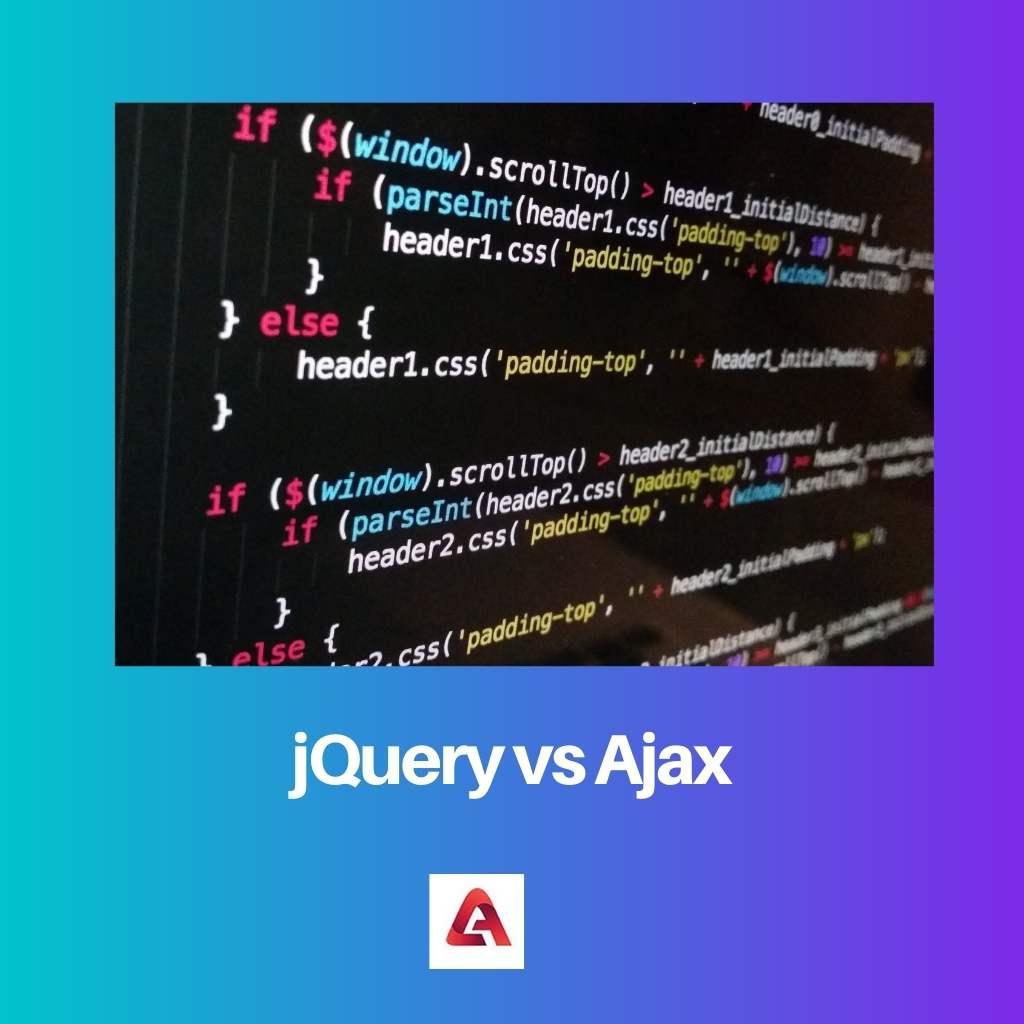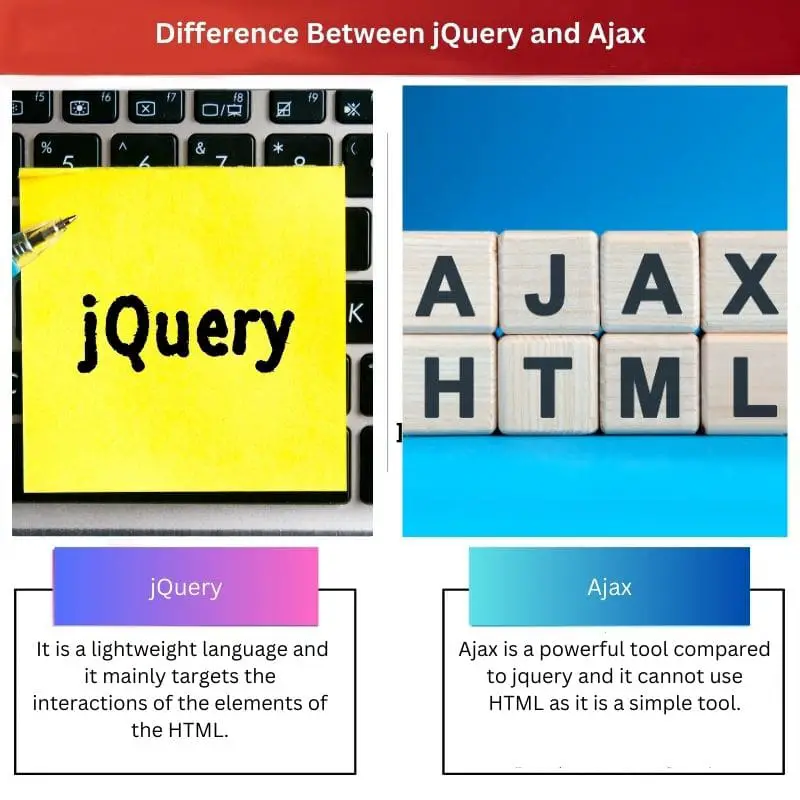Nowadays, there are several programming languages that can be used in developing web pages.
Jquery and Ajax are some of those web programming languages that were developed to provide an efficient, attractive, and user-friendly environment on web pages.
The terms jQuery and Ajax seem to be similar, but these two terminologies have some prominent differences.
Key Takeaways
- jQuery is a JavaScript library that simplifies HTML document traversing, event handling, and animating. At the same time, AJAX (Asynchronous JavaScript and XML) is a technique used for creating fast and dynamic web pages.
- jQuery provides a simplified syntax for performing common JavaScript tasks, while AJAX sends and receives data asynchronously without reloading the entire web page.
- jQuery is a standalone library that can be used with or without AJAX, while AJAX is used with JavaScript libraries like jQuery.
jQuery vs Ajax
jQuery is a fast and lightweight JavaScript library that simplifies HTML document traversal and manipulation, event handling, and animation. It provides a set of APIs. Ajax (Asynchronous JavaScript and XML) is a technology used to send and receive data from a server without requiring a full page reload. Ajax uses a combination of JavaScript, XML or JSON.

jquery is considered an open-source JavaScript library. It helps to simplify the interactions between a CSS/HTML document, precisely the JavaScript and DOM (Document Object Model).
Elaboratively, it simplifies browser event handling, Ajax interactions, DOM (Document Object Model) animations, cross-browser JavaScript development, and HTML document manipulation and travelling.
Ajax stands for Asynchronous JavaScript and XML, which is a new technique for developing faster, better, and more engaging web applications with the help of CSS, JavaScript, HTML, and XML.
For presentation, Ajax uses CSS, and for content, it uses XHTML along with JavaScript and DOM (Document Object Model) for DCD (dynamic content display).
Comparison Table
| Parameters of Comparison | jQuery | Ajax |
|---|---|---|
| Definition | jQuery is considered as an open-source JavaScript library. It helps to simplify browser event handling, Ajax interactions, DOM (Document Object Model) animations, cross-browser JavaScript development, and HTML document manipulation and traveling. | Ajax is a new technique for developing faster, better, and more engaging web applications with the help of CSS, JavaScript, HTML, and XML. |
| Complexity | It is a lightweight language and it targets the interactions of the elements of the HTML. | Ajax is a powerful tool compared to jquery and it cannot use HTML as it is a simple tool. |
| Page reload | After a page is loaded it cannot reload the web page. | After loading a page once Ajax can reload the page again. |
| server overloading | There is no chance of server overloading during working with jquery. | Heavy usage of Ajax can result in server overloading as whenever an Ajax call happens there is an increased number of connections. |
| Functionalities | Jquery is unable to provide new technologies by combining any other technologies. | It is a combination of many other technologies like JS, DOM, CSS, and HTML that provides many new functionalities. |
What is jQuery?
jQuery is considered as an open-source JavaScript library that helps to simplify browser event handling, Ajax interactions, DOM (Document Object Model) animations, cross-browser JavaScript development, and HTML document manipulation and travelling.
Jquery made it very easy to select elements of DOM (Document Object Model) and acts for traversing them and use Sizzle, which is a cross-browser open source selector engine, for modifying their content.
It offers a proper way to capture a wide range of events.
Jquery helps to develop a feature-rich and responsive site by using Ajax technology. It comes with a wide range of default animation effects that are used in websites.
It is a very lightweight library that is gzipped and minified, and its size is about 19KB. It has cross-browser support, which works perfectly in Chrome, Safari, Opera, FF 2.0+, and IE 6.0+.
There are some disadvantages to using Jquery. The client of jquery needs to handle lots of functions created from jquery. It makes the clients slower if it is used excessively.
As a result, developers need to use another cache. It has several functions which depend on the requirements of the site. But there are many functions that are not developed yet. It is a major disadvantage of Jquery.

What is Ajax?
Ajax stands for Asynchronous JavaScript and XML. Ajax is a new technique for developing faster, better, and more engaging web applications with the help of CSS, JavaScript, HTML, and XML.
Ajax is a combination of many other technologies like JS, DOM, CSS, and HTML that provide many new functionalities. It is not a single technology, and it is a term that represents a combination of multiple technologies.
Ajax is a powerful tool compared to jquery, and it cannot use HTML as it is a simple tool. It permits the content of the web pages to be updated very fast when a user uses it without reloading the web page.
The user can not identify the data exchange process on the web page as the action is conducted behind the scene.
There are several advantages of Ajax. It’s easy to use and learn Ajax as it utilizes existing technologies. Its design is to create a more diverse web and enhance the interaction between the users and the website.
Its popularity encourages developing molds that will allow programmers to avoid any pre-collapsed traces.
But there are some disadvantages too. Ajax doesn’t allow it to be bookmarked in the browser as all processes are not visible in the address and occur in the background.
In some browsers, Ajax can not run as the function of JavaScript turns off due to security needs.
Main Difference Between jQuery and Ajax
- jQuery is considered an open-source JavaScript library. It helps to simplify browser event handling, Ajax interactions, DOM (Document Object Model) animations, cross-browser JavaScript development, and HTML document manipulation and travelling. On the other hand, Ajax is a new technique for developing faster, better, and more engaging web applications with the help of CSS, JavaScript, HTML, and XML.
- Jquery is a lightweight language, and it targets the interactions of the elements of HTML. But Ajax is a powerful tool compared to jquery, and it cannot use HTML as it is a simple tool.
- After a page is loaded, jquery can not load the page again, but Ajax can.
- There is no chance of server overloading during working with jquery. Heavy usage of Ajax can result in server overloading, as whenever an Ajax call happens, there is an increased number of connections.
- Jquery is unable to provide new technologies by combining any other technologies. It is a combination of many other technologies like JS, DOM, CSS, and HTML that provide many new functionalities.




